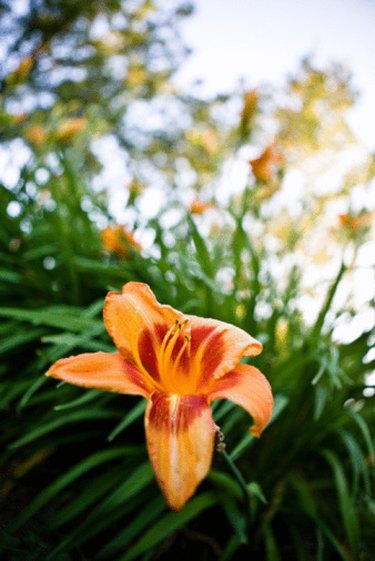
Lilies are probably some of the easiest to recognize flowers, seen growing in gardens, as houseplants and in fields and valleys all over the world. These vibrant plants produce a gentle scent and colors ranging from pure white to vibrant oranges and reds. They can grow in a large variety of areas but do need specific climate and care conditions to thrive.
Temperature
Video of the Day
The only temperature fluctuations that lilies can't handle are the absolute extremes of hot and cold. Lilies can withstand heat into the 90-degree Fahrenheit temperatures and stand up to cold below freezing level. Tropical regions can be a problem since lilies need a cold season that drops below 65 degrees Fahrenheit for at least eight weeks. This dormant season enables them to store up nutrients and energy to produce their next round of blooms; they will do this even if grown indoors where the seasons don't cycle.
Video of the Day
Placement
Place your lilies in an area of your garden (or, if growing indoors, place your pot of lilies) where they will receive at least six hours of full sunlight daily. This sunlight exposure is what enables the lilies to produce their vibrantly colorful flowers. Lilies planted in shade or less-than-full sun will produce long stems that thin out because they are stretching towards the weak sunlight, which makes the lilies more susceptible to damage from temperature and winds.
Soil
Lilies are highly susceptible to fungal growth on leaves, stems and roots, so the soil must be quick to drain. However, the lilies will not sprout in clay-like soil that holds no moisture, so you have to strike a balance between moist and soaked. When you plant, add a few inches of organic amendments like compost, manure or peat moss, which will raise the planting bed slightly, encouraging excess water to run off faster. However, the rich organic amendments will absorb moisture, holding it until the lily needs it to thrive.
Climate Changes
Planting is generally done in early spring, just after the threat of frost has passed, to ensure a good spring and summer bloom. However, though fully-established lilies are not damaged by frost, young plants just starting are. Therefore, after you plant, water the soil well so that it is moist, and pile a 4- to 6-inch layer of organic mulch around the lilies. The mulch will help the soil retain moisture but will also insulate it against the temperature changes in the air to prevent damage from frost (and later from unexpected extreme heat).